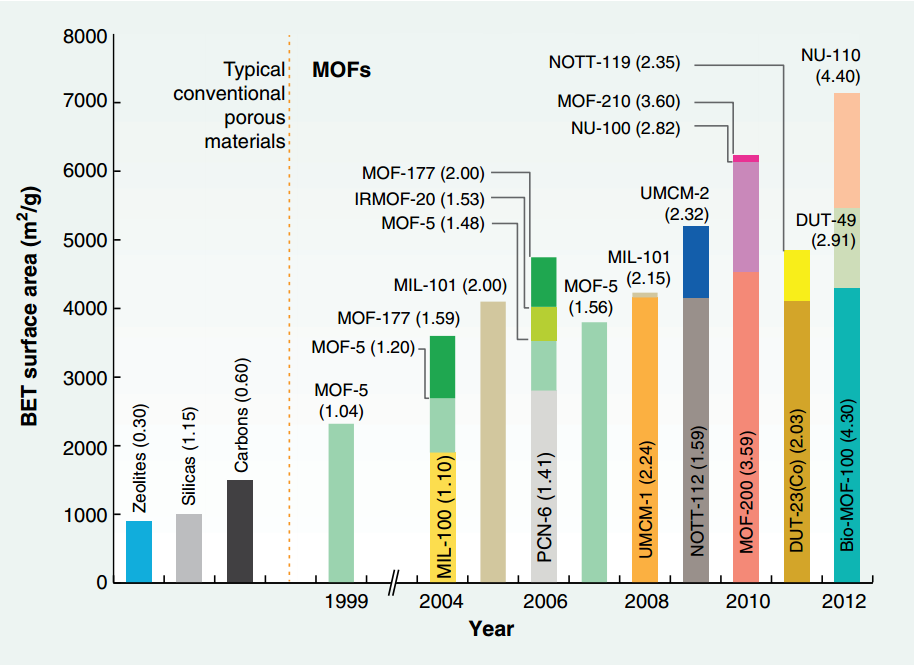
hotline:
17715390137
Tel/Wechat:
18101240246 (Technology)
0512-68565571
Email:mxenes@163.com (Sales Engineer)bkxc.bonnie@gmail.com
Scan the code to follow or search the official account on WeChat:
2D Materials Fronrier After paying attention,
click on the lower right corner to contact us,
Enter enterprise WeChat.
Professional Services Online

Metal-organic framework (MOF) is a network framework structure made by connecting inorganic and organic units through strong bonds. This structure can flexibly change the geometric shape, size and function of the components. According to incomplete statistics, in the past ten years, scientists have reported and studied more than 20,000 different MOFs.
The organic unit is a two- or multi-position organic carboxylate (and other similar negatively charged molecules), when it is connected with a metal-containing unit, it will produce a strong crystalline MOF structure with a typical porosity ratio The general MOF crystal volume is 50% larger. The surface area value of this MOF is usually in the range of 1000 to 10,000 m^2/g, and therefore exceeds the surface area value of traditional porous materials such as zeolite and carbon.
So far, the diversity of MOF with permanent porosity is wider than any other kind of porous material. Research in these areas makes MOF an ideal candidate material for fuel (hydrogen and methane) storage, carbon dioxide capture, and catalytic applications.
In view of this, Hiroyasu Furukawa of the University of California, Berkeley, under the leadership of MOF pioneer Professor Omar M. Yaghi, published in Science magazine entitled The Chemistry and Applications of Metal-Organic Frameworks/Metal-Organic Frameworks/Chemistry and Applications of Metal-Organic Frameworks Review article.

MOF structure
The metal organic framework (MOF) structure is suitable for expanding and merging multiple functional groups within it. (A) The equal mesh extension of MOF maintains the topology of the network by using an extended version of the organic linker. (B) A conceptual diagram of a multi-element MOF (MTV-MOF), the holes of which are decorated with functionally heterogeneous mixtures arranged in a specific order.
40 years of development of MOF

Figure 1. From 1971 to 201, the Cambridge Structural Database (CSD) reported the number of metal-organic framework structures (1D, 2D and 3D)
During this period, all structure types showed a significant growth trend. In particular, the doubling time of the number of 3D MOFs is the largest of all reported metal-organic structures (MOF).
Various secondary structures and organic linkers

Figure 2. Inorganic secondary structure unit (A) and organic linker (B).
The color code in the picture: black, C; green, N; yellow, S; purple, P; light green, Cl; blue polyhedron, metal ion.

Figure 4. Schematic diagram of the synthesis progress of ultra-high porosity MOF
The BET surface area of MOF and typical conventional materials is estimated from gas adsorption measurements. The value in parenthesis represents the pore volume of these materials (cm^3/g). It can be seen from this figure that with the development of porous structure research, the pore volume of porous structure has been greatly improved. From 0.3 of the early zeolite to 1.04 of MOF-5 in 1999, the research has progressed by leaps and bounds in the new century. From 1.10 of MIL-100 in 2004 to Bio-MOF-100de in 2012 4.3. Compared with the original zeolite, the latest research in 2012 increased the specific surface area by 6 times compared with the earlier one.
Porous structure and biological structure

Figure 5. Schematic diagram of the crystal chemical structure of some widely used materials
These versatile materials (metals, alloys, silicon, metal oxides, zeolites, and polymers) are composed of several types of structural units (one to three) to make self-similar materials (left side of the figure), Among them, such structural units will be repeated regularly throughout the material. There are few examples of synthetic crystals with more than three building blocks found in biological structures (protein, RNA, and DNA). Therefore, taking the structure of MOF as an example, the structural units are connected through strong network chemical bonds, which is very useful for the development of "out-of-range materials" structures (such as DNA) and functional spaces.
Heterogeneous MOF material

Figure 6. Examples of heterogeneity in crystalline materials
(A) MTV-MOF-5, in which a heterogeneous mixture of functions decorates the inside of the crystal to provide an environment capable of highly selective binding of carbon dioxide. (B) The schematic diagram of MOCA synthesis shows that MOCA has the heterogeneity created by arranging metal complexes in a specific sequence to provide sequence-related characteristics. (C) Heterogeneity produced in MOF crystals (pmg-MOF-5), in which mesospores and macropores are encapsulated in microporous MOF-5 to produce unusual carbon dioxide capture properties. (D) MOF (MOF-1001) constructed from a linker with a polyether ring, which itself can produce stereoelectronic specific binding substrate paraquat (PQT2 +).
Conclusion
Since it was first reported more than ten years ago, the chemistry and applications of MOF have evolved considerably. Although it is difficult to rule out the possibility that a limited number of MOFs with basic structures will make significant progress, we believe that the future of MOF can become a multi-component and systematic functional material.
references
Hiroyasu Furukawa et al., The Chemistry and Applications of Metal-Organic Frameworks, Science, 2013
DOI: 10.1126/science.1230444
http://science.sciencemag.org/content/341/6149/1230444
Information source: Nanoman
This information is from the Internet for academic exchanges. If there is any infringement, please contact us and delete it immediately

| Reminder: Beijing Beike New Material Technology Co., Ltd. supplies products only for scientific research, not for humans |
| All rights reserved © 2019 beijing beike new material Technology Co., Ltd 京ICP备16054715-2号 |